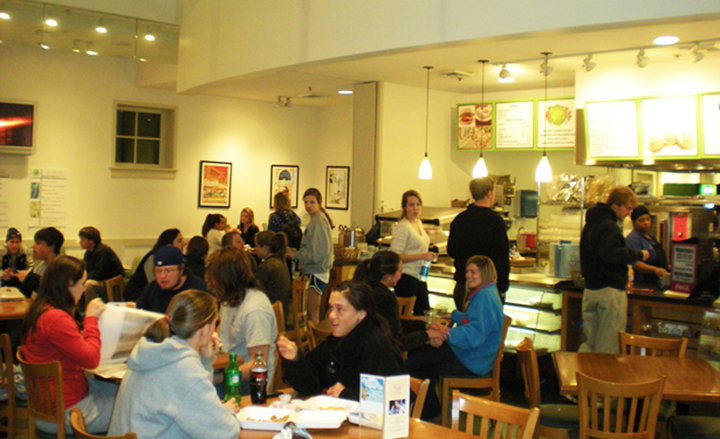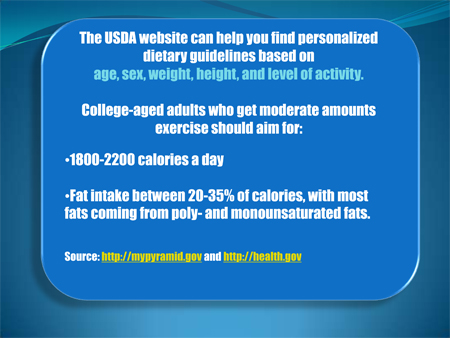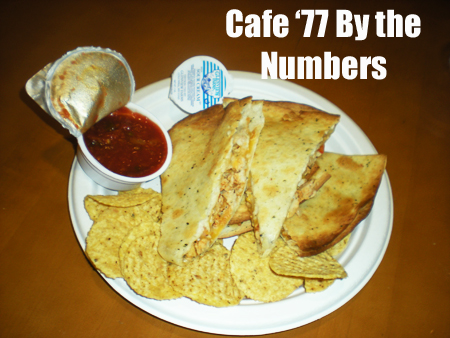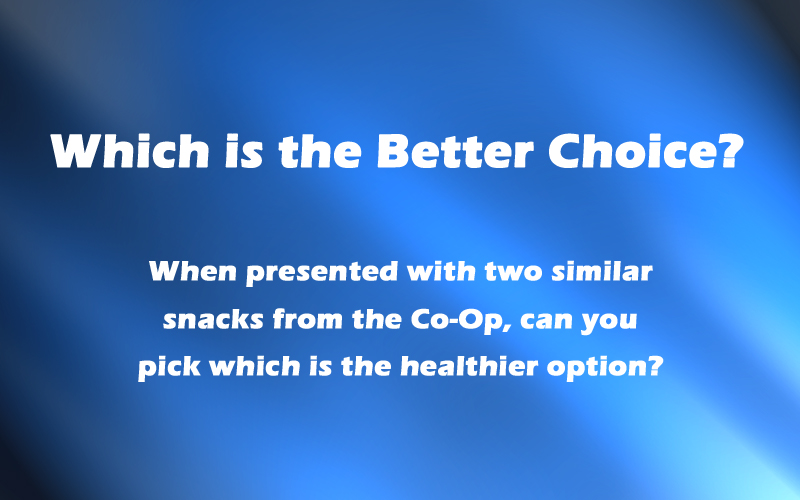 |
Washington and Lee students taking a study break in Cafe '77. Photo by Katy Stewart |
College students on the go: Are you making healthful choices?
April 13, 2011
College students are often busy, stressed, and night owls, three things that don't always lead to healthful food choices. We talked to a nutritionist about guidelines for healthful eating, tips for forming good habits, and pitfalls to avoid. We also did some of the legwork for you, breaking down the nutritional stats of favorite foods served at Washington and Lee's Cafe '77 and Co-op- knowing what you eat can lead to making healthier choices. Check out the Cafe '77 numbers and see how you do in the Co-Op quiz.

Amanda Kaster, R.D. shares information and tips about eating healthfully for college students.
- Many college students rely on a carb-heavy diet of foods like bagels, snack bars, smoothies, and yogurt, and don’t balance their choices with enough protein and healthy fats.
- Carb-heavy diets augment blood sugar levels. Simple carbohydrates are absorbed quickly, causing your blood sugar to spike then crash. This causes cravings which can lead to overeating, especially carbs, so the cycle is self-perpetuating.
- Salt, sugar, and fat are triggers for cravings. That’s why many people crave “sweet and salty” combinations. Fill your body with whole, real foods instead.

- College students who eat a lot of sugar are prone to gain fat mass, because when most of your day is spent sitting in class instead of moving around, the carbs aren’t used as fuel, and are stored as fat.
- Calorie counting can become obsessive. If you can stop cravings and stress eating by managing your blood sugar levels, you can aid your body in balancing out calories on your own.
- If you want to last from breakfast to lunch, your breakfast should include protein and fat; it needs to be more than lowfat milk and cereal, which are both carbs.
- For lunch and dinner, break your meal down when building your plate. Half should be carbs, and the other half should be fats and proteins, with 2-3 servings of carbs and 1-2 servings of protein.
- Be aware of serving sizes. A serving of starch is about ½ cup.
- Vegetables are great plate fillers, but make sure you count the starchy vegetables as starches, such as corn, peas, beans, and potatoes.
- Fruits are carbs as well, but they are complex so they don’t make your blood sugar spike as quickly.
- Try to eat fruits and vegetables of each of these five colors every other day or more: red, yellow/orange, green, white, blue/purple.
- Skipping meals isn’t healthy, and while people use it as a weight-loss strategy, it can actually cause cravings. Instead of saving calories, most students overcompensate later in the day. Skipping meals also slows your metabolism, making it harder to lose fat mass.
- Sleep is an important factor for healthy eating, because it regulates your metabolism. Shoot for 6-8 hours of sleep a night.
- College students who stay up late studying often find that they get hungry several hours after dinner. If this happens, have a mini-snack of a carb and a protein, like crackers and cheese or an apple and peanut butter.
- Stress negatively augments eating habits, as people tend to either overeat, or undereat and overcompensate when the stress is over.

- Hydration is important for healthy living, and it plays a part in healthy eating, too, because many people confuse thirst for hunger since the feelings are similar.
- Many people think that “energy in should equal energy out,” but this is not necessarily true. Different foods are used differently by the body, and healthful eating depends on the quality of food, not just the quantity. Not all calories are created equally. Again, try to incorporate real, whole foods into your diet, instead of prepackaged, processed foods.
- College students aren’t going to eat perfectly all the time. Just plan the rest of your meal around the pizza, French fries, cake, or whatever indulgence comes along. For example, have French fries with your meal, but stick to the serving size and remember that this counts as your starch, so don’t order the hamburger, which has a bun, go for the chicken instead.
- The best way to eat healthfully on campus is to take control of your diet and speak up! Communicate what your food needs are. Recruit friends who also want to eat healthfully and request healthy choices from dining services.
- Label reading is important. You can really control what you eat when you shop at the grocery store. Learn what serving sizes are, how much fat is in different foods, and other statistics so that when you eat out, you will know more. Practice so you get better. Control what you eat without obsessing.
Use your resources! Check out: mypyramid.gov, the USDA's guidelines for Americans nutritiondata.com, an extensive database to look up nutrition stats for thousands of foods.
|
| Regional events calendar |
Local government websites: |
Produced by Washington and Lee digital journalism students.
![]()




